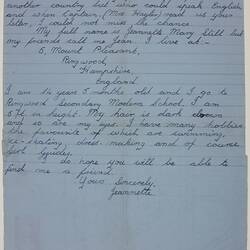Summary
Two handwritten aerograms addressed to Lucy Hathaway and the 8th Ballarat Girl Guides Company by two members of the 2nd Ringwood Guides, Hants, England, dated 23 April 1959. Lucy Hathaway had migrated to Australia from England with her family in 1951 and lived in Ringwood before coming to Australia. She and her daughters were involved in brownies and girl guiding in England and then went on to become very active in the Ballarat area where they settled. One letter written by Beryl Hayter is part of an exchange of news between the two companies, and refers to Australia being the subject of their 'Thinking Day' as well as a request for pen-friends for two members. It also exchanges personal news and asks after Lucy's daughters Hazel and Merle. The other letter is a request by Jeanette Still for a pen-friend from the Ballarat Company.
Stanley and Lucy (nee Simmons) Hathaway and their daughter Hazel survived World War II in heavily bombed Coventry, England, remaining there until 1946. They attended the Victory in Europe Day (VE Day) celebrations there on 8 May 1945. The Hathaways relocated to Buckinghamshire (where second daughter Merle was born in 1948) and Hampshire between 1946 and 1951, finally deciding to migrate to Australia. They applied successfully to the Assisted Passage Migration Scheme but had to wait two years before departing, living and touring England in a caravan until departing on the 'New Australia' 17 November, 1951. They first stayed at the Bathurst Migrant Camp in New South Wales before being relocated to a housing commission estate in Ballarat, Victoria. Within six months they had purchased a block of land, living in a caravan while their house was built. The family became active members of the local Ballarat community, with Lucy working for the newly established McCallum House Centre for Retarded Children at Sebastopol and continued her strong interest in the Brownies and Girl Guides associations.
Physical Description
Two letters handwritten in blue ink on aerogram paper. Both have the aerogram stamp in blue and a red sixpence postage stamp printed on the header.
Significance
This collection represents the experiences of thousands of post-war assisted migrants from England who brought with them memories of danger, sadness, courage, austerity and celebration in both tangible and intangible forms. This family survived one of the most severe bombings of any English city during World War II and brought with them material symbols of endurance and triumph in the Victory Day dress and Union Jack flag, symbols with almost universal resonance. The collection also includes items which tell stories about the goods migrants select in order to start new lives, the adventure of the ship voyage, and the seeking of familiar interests in a new community. The collection also explores the theme of maintaining connections and loyalties to homeland, in this case through memorabilia relating to the British monarchy and exchange projects with former local communities.
More Information
-
Collecting Areas
Migration & Cultural Diversity, Public Life & Institutions, Leisure, Childhood
-
Acquisition Information
Donation from Merle Hathaway, 28 May 2010
-
Addressed To
-
Previous Owner
-
Inscriptions
One letter: [addressee] 'Girl Guides of the 8th Ballarat Company/c/o Mrs L.J. Hathaway/29 Grammar Street/Wendouree/Victoria/Australia; [sender] Mrs Hayter/89 Hightown Road/Ringwood, Hants, England' Second letter: [addressee] 8th Ballarat Guide Company/Mrs L. Hathaway/29 Grammar Street/Wendouree/Victoria/Australia; [sender] Miss J Still/5 Mount pleasant/Ringwood, Hants/England'
-
Classification
-
Category
-
Discipline
-
Type of item
-
Overall Dimensions
240 mm (Width), 200 mm (Height)
-
Keywords
British Immigration, Childhood, Girl Guides & Brownies, Migrant Camps, Migrant Reception Centres, Migration & Settlement






